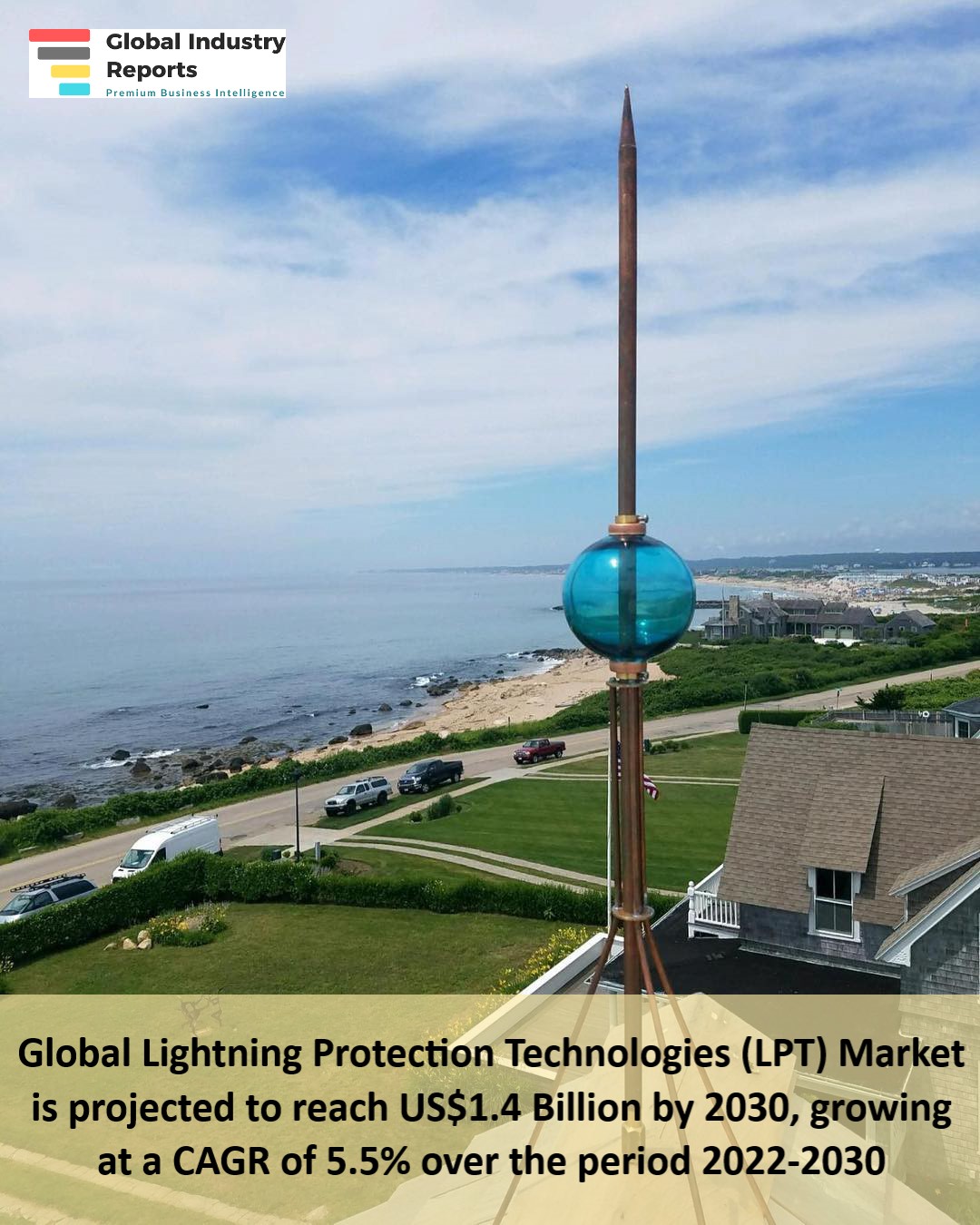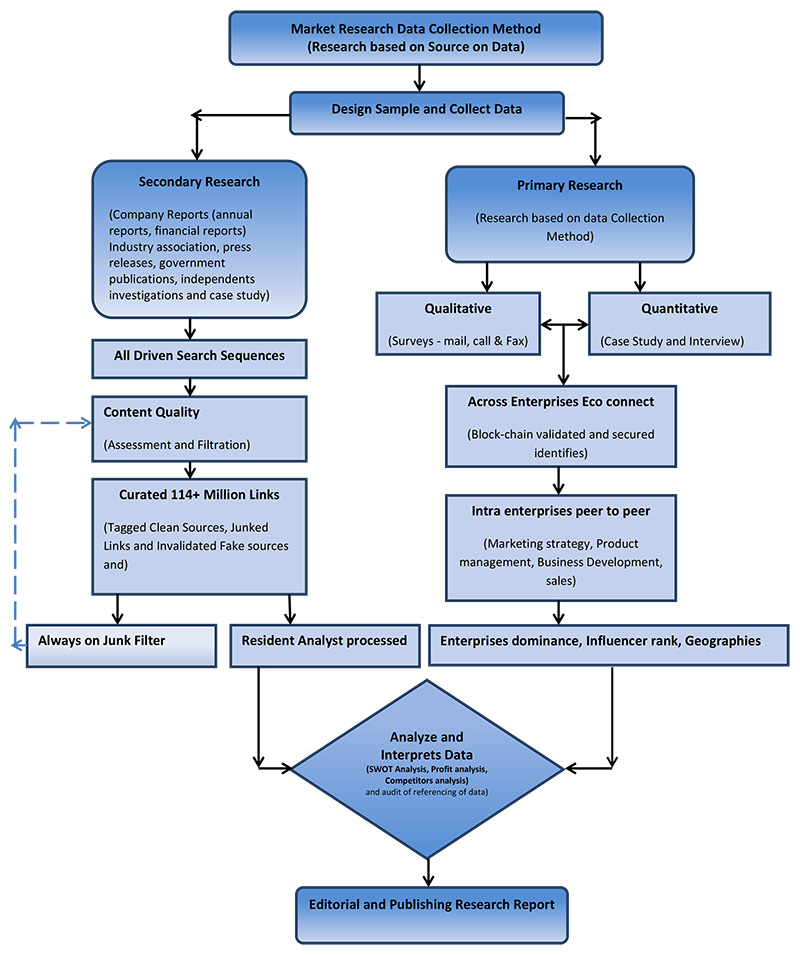Report Overview
- Understand the latest market trends and future growth opportunities for the Lightning Protection Technologies (LPT) industry globally with research from the Global Industry Reports team of in-country analysts – experts by industry and geographic specialization.
- Key trends are clearly and succinctly summarized alongside the most current research data available. Understand and assess competitive threats and plan corporate strategy with our qualitative analysis, insight, and confident growth projections.
- The report will cover the overall analysis and insights in relation to the size and growth rate of the “Lightning Protection Technologies (LPT) Market” by various segments at a global and regional level for the 2010-2030 period, with 2010-2021 as historical data, 2022 as a base year, 2023 as an estimated year and 2023-2030 as forecast period.
Description:
- The global market for Lightning Protection Technologies (LPT) estimated at US$891.2 Million in the year 2022, is projected to reach a revised size of US$1.4 Billion by 2030, growing at a CAGR of 5.5% over the period 2022-2030.
- Conventional, one of the segments analyzed in the report, is projected to record 5.9% CAGR and reach US$874.6 Million by the end of the analysis period. Growth in the Unconventional segment is estimated at 4.7% CAGR for the next 8-year period.
- The Lightning Protection Technologies (LPT) market in the U.S. is estimated at US$171 Million in the year 2022. China, the world`s second largest economy, is forecast to reach a projected market size of US$271.3 Million by the year 2030 trailing a CAGR of 6.7% over the analysis period 2022 to 2030. Among the other noteworthy geographic markets are Japan and Canada, each forecast to grow at 3.9% and 4.9% respectively over the 2022-2030 period. Within Europe, Germany is forecast to grow at approximately 4.6% CAGR.

MARKET DATA INCLUDED
- Unit Sales, Average Selling Prices, Market Size & Growth Trends
- COVID-19 Impact and Global Slowdown Analysis
- Analysis of US inflation reduction act 2022
- Global competitiveness and key competitor percentage market shares
- Market presence across multiple geographies – Strong/Active/Niche/Trivial
- Online interactive peer-to-peer collaborative bespoke updates
- Market Drivers & Limiters
- Market Forecasts Until 2030, and Historical Data up to 2015
- Recent Mergers & Acquisitions
- Company Profiles and Product Portfolios
- Leading Competitors
The Report Includes:
- In-depth exploration of the industry, encompassing definitions, classifications, and the industry’s interconnected structure.
- Examination of pivotal supply-side and demand trends.
- Detailed breakdown of both international and local products.
- Insight into historical volume and value dimensions, along with market shares of companies and brands.
- Five-year predictions regarding market trends and growth.
- A robust and transparent research methodology conducted within the country.
- A blend of qualitative and quantitative analysis, grounded in segmentation that considers economic and non-economic aspects.
- Provision of market value data (in USD Billion) for every segment and sub-segment.
- Geographical, regional, national, and state-wise analysis.
- A succinct overview of the commercial potential inherent in products, technologies, and applications.
- Company profiles of key market players operating within the product category.
- Descriptions of attributes and manufacturing processes.
- Segmentation based on type, application, end-users, regions, and other factors.
- Discussion about the current state, challenges, innovations, and future requirements of the market.
- Examination of the market based on application and product sizes: utility-scale, medium scale, and small-scale.
- Country-specific insights and analyses for major countries and regions.
- Coverage of historical context, pivotal industrial developments, and regulatory frameworks.
- Analysis of competitive movements, including agreements, expansions, new products, and mergers & acquisitions.
- Exploration of opportunities for stakeholders and a depiction of the competitive landscape among market leaders.
- Specialized coverage of significant global events, such as the Russia-Ukraine war, global inflation, China’s “zero-Covid” policy shift, supply chain disruptions, trade tensions, and the risk of recession.
- Evaluation of global competitiveness and market shares among key competitors.
- Presence assessment across various geographical markets: Strong, Active, Niche, Trivial.
- Online, interactive, peer-to-peer collaborative updates.
- Access to digital archives and the Market Research Platform.
- Complimentary updates for a two-year period.
Green Building Materials Reports Scope and Segments:
| Report Attribute | Details |
| Market size value in 2022 | USD 891.9 Million |
| Revenue forecast in 2030 | USD 1.4 Billion |
| Growth Rate | CAGR of 5.5% from 2022 to 2030 |
| Base year for estimation | 2022 |
| Historical data | 2015 – 2022 |
| Forecast period | 2023 – 2030 |
| Quantitative units | Revenue in USD million and CAGR from 2023 to 2030 |
| Report coverage | Revenue forecast, company ranking, competitive landscape, growth factors, trends, DROT Analysis, Market Dynamics and Challenges, and Strategic Growth Initiatives
COVID-19 Impact, Market Growth Trends, Market Limiters, Competitive Analysis & SWOT for Top Competitors, Mergers & Acquisitions, Company Profiles, Product Portfolios Market Size, Market Shares, Market Forecasts, Market Growth Rates, Units Sold, and Average Selling Prices. |
| Segments covered | Product, Type, Platform, Application & Region |
| Regional scope | North America; Europe; Asia Pacific; Latin America; Middle East and Africa and rest of the world |
| Country scope | United States, China, Japan, Germany, India, United Kingdom, France, Brazil, Italy, Canada, South Korea, Australia, Russia, Spain, Mexico, Indonesia, Netherlands, Switzerland, Saudi Arabia, Turkey, Taiwan, Poland, Sweden, Belgium, Thailand, Austria, Nigeria, Argentina, United Arab Emirates, Iran, Norway, Israel, Ireland, Malaysia, Denmark, Singapore, Philippines, Pakistan, Finland, Chile, Vietnam, Greece, Czech Republic, Romania, Portugal, Peru, New Zealand, Hungary, Iraq, Bangladesh, Qatar, Kuwait, Ukraine, Egypt, Kazakhstan, Colombia, Angola, Algeria, Morocco, Slovakia, Oman, Puerto Rico, Ethiopia, Sudan, Kenya, Ghana, Dominican Republic, Myanmar, Tanzania, Ecuador, Belarus, Guatemala, Lithuania, Latvia, Sri Lanka, Nepal, Lebanon, Slovenia, Bahrain, Libya and others |
| Key companies profiled | A. C. Harahan Lightning Rods; A.N. Wallis & Co. Ltd.; ABB Ltd; Alltec Corporation; APC by Schneider Electric; API Technologies Corporation; AXIS Electrical Components Pvt. Ltd.; Bonding Conductors; Bourns, Inc.; Cirprotec SL; Clearline Protection Services (Pty) Ltd.; Cooper; DEHN SE + Co KG; Delta T; East Coast Lightning Equipment, Inc.; Eaton Corporation; Ekspan Ltd; Elemko SA; Ennov Infra Solutions Private Ltd.; Ensto; Erico; ERITECH; Exar Industries; Fatech Electronic Co., Ltd.; Franklin Electric Co., Inc.; Furse; GE Grid; Gersan Elektrik; HAKEL; Harger Lightening and Grounding; Hubbell; HUBER+SUHNER AG; INAEL Electrical Systems SA (INAEL); Indelec; Independent Protection Company; INGESCO; Jishnu Control Systems; K.M.L.Technology; Kingsmill Industries; Kumwell Corporation; Lamco; LEC Global; Leeweld; Lightning and Grounding; Lightning Defense; Lightning Eliminators; Lightning Master; Lightning Preventor of America; Lightning Protection International (LPI); Lightning Protection System (LPS); Lightning Storm Lightning Protection; McWane, Inc.; MEIDEN (TRIDELTA); Metal Gems; MTL Instruments Group; NexTek Inc.; Northern Powergrid; Nvent; OBO Bettermann; Pentair Plc; Prevectron; Raycap; RidgeGear; Robbins Lightening; Shreem; Siemens AG; Stormin Protection Products; Streamer, Inc.; Super Impex; TE Connectivity Ltd; TFC Group; Thompson Lightning Protection; TOSHIBA; Tridium, Inc.; TSTLP; U-VENTURES; Wallis; Whitehead & Kales and Others |
| Customization scope | Free report customization (equivalent up to 20 analyst’s working days) with purchase. Addition or alteration to country, regional & segment scope. |
| Report Format | PDF, PPT, Excel & Online User Account |
Lightning Protection Technologies (LPT) Report Segemented By:
Lightning Protection Technologies (LPT) Market By Technology:
- Conventional
- Unconventional
Lightning Protection Technologies (LPT) Market by Product Type:
- Lightning Rod Systems
- Lightning Rod with Taut Wire Systems
- Lighting Conductor with Meshed Cage Systems
- Air Terminals and Adaptors
- Conductors
- Fittings and Connectors
- Grounding Equipment
- Surge Protectors
- Others
Lightning Protection Technologies (LPT) Market by End-user:
- Commercial
- Residential
- Industrial
Lightning Protection Technologies (LPT) Market By Region:
- North America
- Europe
- Asia Pacific
- South America
- Middel East & Africa
- Rest of the World
Companies covered in Lightning Protection Technologies (LPT) market Report:
| A. C. Harahan Lightning Rods | Lamco |
| A.N. Wallis & Co. Ltd. | LEC Global |
| ABB Ltd | Leeweld |
| Alltec Corporation | Lightning and Grounding |
| APC by Schneider Electric | Lightning Defense |
| API Technologies Corporation | Lightning Eliminators |
| AXIS Electrical Components Pvt. Ltd. | Lightning Master |
| Bonding Conductors | Lightning Preventor of America |
| Bourns, Inc. | Lightning Protection International (LPI) |
| Cirprotec SL | Lightning Protection System (LPS) |
| Clearline Protection Services (Pty) Ltd. | Lightning Storm Lightning Protection |
| Cooper | McWane, Inc. |
| DEHN SE + Co KG | MEIDEN (TRIDELTA) |
| Delta T | Metal Gems |
| East Coast Lightning Equipment, Inc. | MTL Instruments Group |
| Eaton Corporation | NexTek Inc. |
| Ekspan Ltd | Northern Powergrid |
| Elemko SA | Nvent |
| Ennov Infra Solutions Private Ltd. | OBO Bettermann |
| Ensto | Pentair Plc |
| Erico | Prevectron |
| ERITECH | Raycap |
| Exar Industries | RidgeGear |
| Fatech Electronic Co., Ltd. | Robbins Lightening |
| Franklin Electric Co., Inc. | Shreem |
| Furse | Siemens AG |
| GE Grid | Stormin Protection Products |
| Gersan Elektrik | Streamer, Inc. |
| HAKEL | Super Impex |
| Harger Lightening and Grounding | TE Connectivity Ltd |
| Hubbell | TFC Group |
| HUBER+SUHNER AG | Thompson Lightning Protection |
| INAEL Electrical Systems SA (INAEL) | TOSHIBA |
| Indelec | Tridium, Inc. |
| Independent Protection Company | TSTLP |
| INGESCO | U-VENTURES |
| Jishnu Control Systems | Wallis |
| K.M.L.Technology | Whitehead & Kales |
| Kingsmill Industries | Others |
| Kumwell Corporation |
After Sales Support
- Every updated edition of the report and full data stack will be provided at no extra cost for 24 months.
- Latest 2022 base year report.
- Free Updated edition of 2023 every quarter without any hidden cost.
- No user limitation for the report. Unlimited access within the organization.
- Unrestricted post-sales support at no additional cost
- Free report customization (equivalent up to 10 analyst’s working days) with purchase. Addition or alteration to country, regional & segment scope
- Global Industry Reports will support your post-purchase for a period of 24 months to answer any of your queries related to the following market and to provide you any more data needed, for your analysis.
- Option to purchase regional or some selected Chapters from the report.
Key questions that are answered in this report:
- What Are Lightning Protection Technologies (LPT), and How Do They Work?
- What Are the Key Factors Driving the Growth of the Global Lightning Protection Technologies Market?
- What Are the Major Types of Lightning Protection Technologies Available?
- How Does Climate and Geography Impact the Adoption of Lightning Protection Technologies?
- What Are the Impacts of Lightning Strikes on Buildings and Structures?
- What Are the Different Components of a Lightning Protection System?
- How Does the Global Lightning Protection Market Vary by Industry?
- What Are the Latest Innovations in Lightning Protection Technologies?
- How Does Regulatory Compliance Affect the Installation of Lightning Protection Systems?
- What Are the Key Challenges Faced by the Lightning Protection Industry?
- How Does Lightning Protection Technology Compare to Surge Protection Devices?
- What Is the Role of Lightning Protection in Renewable Energy Systems?
- What Are the Safety Benefits of Lightning Protection in Residential Areas?
- What Impact Does Climate Change Have on Lightning Frequency and Protection Needs?
- What Are the Emerging Trends in Lightning Protection for Telecommunications and Data Centers?
- How Is the Aviation Industry Addressing Lightning Protection for Aircraft?
- What Is the Significance of Lightning Protection in Historical and Cultural Sites?
- How Does the Global Lightning Protection Market Vary by Region?
- What Are the Advantages of Early Streamer Emission (ESE) Lightning Protection Systems?
- What Are the Key Considerations When Designing Lightning Protection for Tall Structures?
- How Are Lightning Protection Technologies Incorporating Sustainable Practices?
- What Is the Market Size and Growth Projection for the Global LPT Market?
- What Are the Top Lightning Protection Technology Manufacturers and Suppliers?
- How Is Lightning Protection Technology Contributing to Public Safety and Infrastructure Resilience?
- What Are the Cost Factors Associated with Lightning Protection System Installation and Maintenance?









